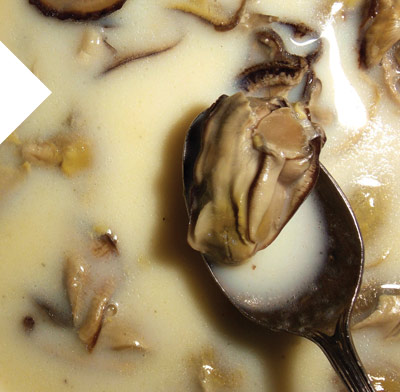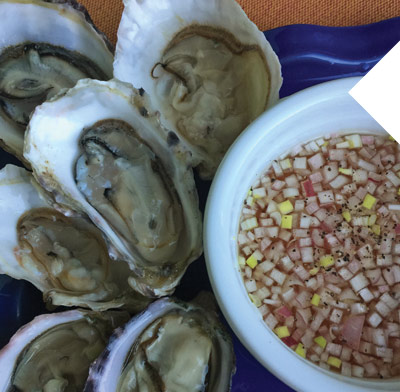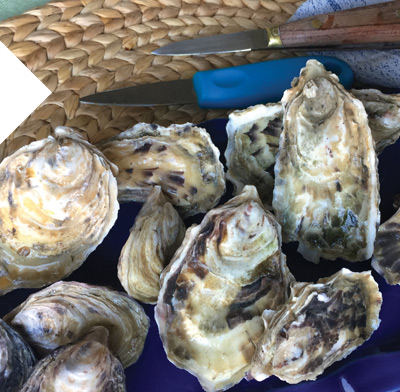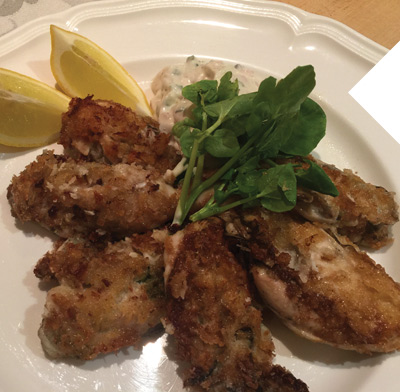I recently had the opportunity to travel to Totten Inlet in South Puget Sound for a beautiful evening on the beach at low tide where I slurped oysters, those delicious, briny delights from the sea. The location was the Taylor Shellfish beach, and the event was the Walrus and Carpenter Picnic founded by seafood great Jon Rowley. Lewis Carroll’s poem The Walrus and Carpenter inspired Rowley to start this picnic, and the event benefited the Puget Sound Restoration Fund, a non-profit dedicated to the protection of the environment. The cold waters of winter are the best for eating oysters, and true to form it was cold, extremely rainy, and the beach was muddy due to all the intense rain. But it didn’t matter; we had a beautiful crisp glass of white wine and an oyster knife, and we were left to wander the beach to hunt for the perfect oyster, our choices being Olympias, Pacifics, Kumomotos, or Totten Virginicas varieties.
I love oysters and have many memories as a kid wandering the beach with my dad in search of big oysters to grill on our beach fire. Back then, I didn’t really enjoy oysters, but as I got older and worked my way from clams to mussels then oysters, a deep appreciation blossomed. At the recent picnic, I had a chance to chat with Betsy Peabody, the Executive Director of the Puget Sound Restoration Fund.
“People flock to these picnics (always in winter, always at night) to soak up and drink in everything the Northwest has to offer, regardless of weather. Even in the snow or rain, people are lined up because they want to experience firsthand the resources and abundance that still define our region. This kind of direct experience underscores the importance of maintaining a healthy Puget Sound,” she told me. The guests of the picnic were taught by the crew from Taylor Shellfish about clean water, healthy shorelines, and what it takes to grow beautiful oysters in Puget Sound. Peabody talked about how the Washington Department of Health keeps a close eye on water quality and quickly shuts down shellfish beaches if the water quality dips below a certain level.
As a boater, I love the fact that we can hop in our boats big and small and go to lovely areas of Puget Sound to hike the beaches, harvest oysters, fish, or drop a crab trap. We all love the beauty of our area; the sunsets and sunrises, wildlife, smells, and vistas. We are lucky to live in this area! At times we tend to lose sight of what it takes to keep our Sound healthy, but as boaters, we can do a lot to help. Historically, the precious native Olympia oyster started to disappear due to industry in the South Sound, but they are back and healthy, along with four other oyster types: Virginica, Pacific, Kumamoto, and the European Flat. These other varietals came in as ballast or were brought in more recently by oyster farmers hoping to expand their line-up. These oyster varietals exist throughout Washington waters, are grown regionally, and given their names after their origins, such as Totten Inlet, Baywater, Penn Cove, or Pickering Passage. Puget Sound is a quirky body of water, and the oysters are very sensitive to the microclimates in these different areas. Some oysters grow well in one area, but not in another. Factors like water depth, salinity, temperature, and acidity all affect the oyster. The oyster really is a bellwether for the health of our Puget Sound, and it’s up to us as boaters to do what we can to protect the environment in which they, and we, live.
The best way to enjoy the oyster is raw on the half shell on a beach around midnight in winter, but if organizing the beach and such is difficult, you can pick up some oysters at most grocery stores. If the raw oyster is hard for you to eat, try grilled, or breaded and pan fried on a roll as a Po Boy, or plain on fresh tomato pasta. Oyster stew served to us by Xinh Dwelley (of oyster shucking fame) at the end of the picnic was warm and thick with a pile of small oysters at the bottom of the cup. Amazing. It is a shame to cook oysters, but if you are, the following recipes do justice to our briny little friends.

|
Oyster Stew
In a heavy bottomed pot, melt the butter and add the carrots, celery, and shallots. Cook on low, add the leeks, and cook for five or six minutes. Increase the heat and add the wine. Allow the wine to deglaze, then reduce the heat and add the herbs, oyster nectar, and milk. Reduce heat and cook for 20 minutes. Turn the heat off and hold until you are ready to serve. When ready to serve, bring to a simmer and add oysters, juice, and cream. Stir gently until properly heated through, season, and serve in warm bowls. |
Shucked Oysters
Combine all the ingredients and chill.For shucking oysters, a shorter blade and wide-handle knife works really well with Olympias and other smaller oysters. Again, the winter months are best for eating oysters, but there are locations throughout the Northwest that grow oysters year round. The Washington State Department of Fish and Wildlife has an extensive webpage devoted to shellfish. There are countless videos on the internet for how to shuck an oyster, and like any skill, it takes time. The faster you are, the more oysters you get to eat! Shucked oysters are best small and plain or if you must, with a bit of fresh lemon, some mignonette, or a splash of hot sauce. |

|

|
Grilled OystersFor grilled oysters, build a hot fire, or heat your grill to 500 degrees. Choose 3-4 inch oysters, and use a thick kitchen hot pad or towel and tongs for pulling your oysters off the grill. Put the oysters on the grill with the flat side facing up. As the oyster grills and heats up, the top shell will pop open and the nectar in the belly will steam the oyster meat. You may need to grip the oyster, keeping it level to pry the top shell off. Eat the oyster off the grill, right out of the shell. |
Pan Fried Oysters
Drain your jar of oysters in a mesh strainer, saving the nectar for stew, then lay them out on paper towels to dry more. Lightly sprinkle with flour and add to the egg wash coating them well. Then move the oysters to the breadcrumbs. Be gentle coating the oysters, so as to not damage the meat. Coat the oysters well and set them aside to fry. To fry the oysters, heat a flat fry pan on medium with an inch of oil in the pan. As the oil begins to shimmer and becomes hot, add the well-breaded oysters, making sure to keep the fry to a golden brown on each side. Remove to paper towels to dry, season with salt, and keep the pan hot as you add oysters. Leave space between the oysters as they cook. You are looking for golden brown on both sides. Remove to paper towels, season, and serve with remoulade sauce. Remoulade Sauce
In a small bowl blend mayonnaise with capers, cornichons, shallots, parsley, salt, and pepper. Blend, adjust the seasoning with lemon and cayenne, and serve chilled. |

|


